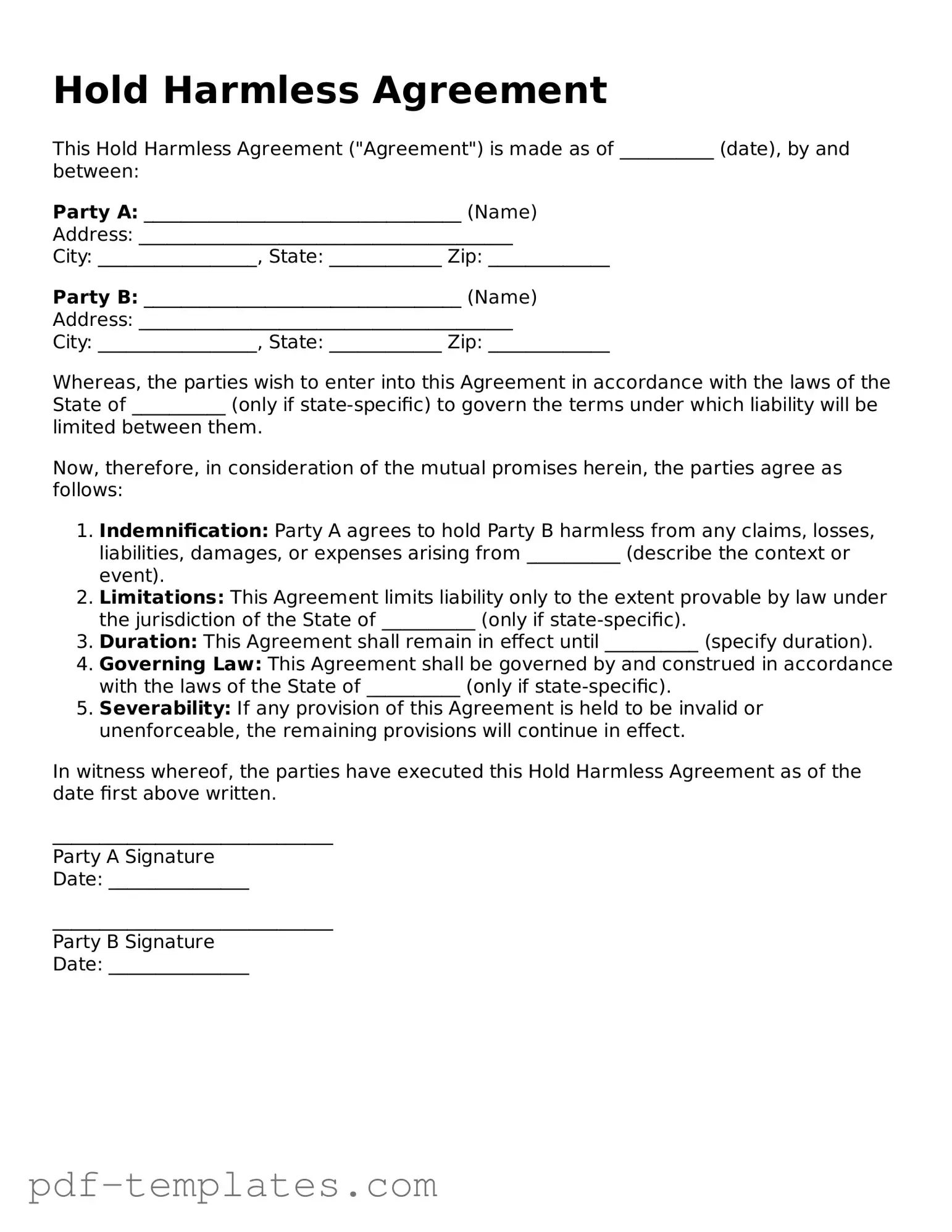A Waiver of Liability is similar to a Hold Harmless Agreement in that both documents protect one party from being held liable for injuries or damages. In a Waiver of Liability, an individual agrees not to hold another party responsible for any potential risks associated with a specific activity. This document is often used in sports, recreational activities, or events where participants may face risks. Both agreements serve to inform participants of potential dangers and require them to accept those risks voluntarily.
An Indemnity Agreement is closely related to a Hold Harmless Agreement, as it involves one party agreeing to compensate another for any losses or damages incurred. While a Hold Harmless Agreement primarily protects one party from liability, an Indemnity Agreement shifts the financial burden of damages from one party to another. This document is often used in business contracts, ensuring that if one party faces a lawsuit or claim, the other party will cover the costs.
A Release of Liability form is another document that shares similarities with a Hold Harmless Agreement. Both documents aim to limit the liability of one party. A Release of Liability typically requires an individual to relinquish their right to sue for any injuries or damages that may occur during an activity. This form is often used in situations where participants engage in potentially hazardous activities, such as adventure sports or community events.
A Consent Form can also be likened to a Hold Harmless Agreement, as it involves an individual agreeing to participate in an activity after being informed of the associated risks. While a Consent Form primarily serves to obtain permission, it may also include language that limits the liability of the organization hosting the activity. This document ensures that participants are aware of the risks and agree to take responsibility for their involvement.
In considering various legal documents, it's important for individuals to understand the California Identification Card application process, which provides a vital service to residents. For those looking to apply for, renew, or replace their ID, the detailed instructions found within this public service document are essential. Furthermore, potential applicants should refer to All California Forms for comprehensive guidelines, including eligibility requirements and considerations related to Social Security Numbers.
A Safety Agreement is another document that bears resemblance to a Hold Harmless Agreement. This type of agreement outlines the safety protocols and procedures that participants must follow during an activity. While it emphasizes safety, it may also include clauses that limit liability for the organizers. By signing a Safety Agreement, participants acknowledge their understanding of the risks and agree to adhere to safety measures.
A Liability Insurance Policy is a document that provides financial protection against claims of negligence or injury. While it is not an agreement between parties, it serves a similar purpose by mitigating the financial risks associated with liability. Organizations often require participants to have liability insurance, ensuring that they are protected in the event of an accident or injury. This policy complements a Hold Harmless Agreement by providing an additional layer of security.
An Acknowledgment of Risk form is similar in intent to a Hold Harmless Agreement. This document requires individuals to acknowledge the inherent risks associated with an activity before participating. By signing this form, participants confirm their understanding of the risks involved and agree to accept them. This acknowledgment serves as a reminder of the potential dangers and reinforces the participant's responsibility for their safety.
A Participant Agreement is another document that often parallels a Hold Harmless Agreement. This agreement outlines the terms and conditions of participation in an event or activity. It typically includes clauses that limit liability and require participants to assume responsibility for their actions. By signing a Participant Agreement, individuals agree to abide by the rules and accept the risks associated with their participation.
Finally, a Contract for Services may share similarities with a Hold Harmless Agreement, particularly when it includes liability clauses. This document outlines the terms of a service arrangement and may specify the responsibilities of each party regarding liability. By including a Hold Harmless clause, the contract can protect one party from claims related to the services provided, ensuring that both parties understand their obligations and risks.
